University Library System: Software Engineering Project Documentation
VerifiedAdded on 2023/04/21
|20
|1954
|359
Project
AI Summary
This document presents a detailed software engineering project focused on the design and documentation of a library system. The project begins with an overview of project planning, including a Gantt chart and Trello board link. It then delves into requirements documentation, outlining user, functional, and non-functional requirements, with a specific focus on the "Pay Fine" scenario. Use case, sequence, class, and activity diagrams are provided to visually represent the system's functionality and interactions. User interface designs for both administrator and member interfaces are included, showcasing the system's user experience. Finally, the project concludes with test case generation, demonstrating how the system's functionality is validated. The document also contains a bibliography of relevant sources.
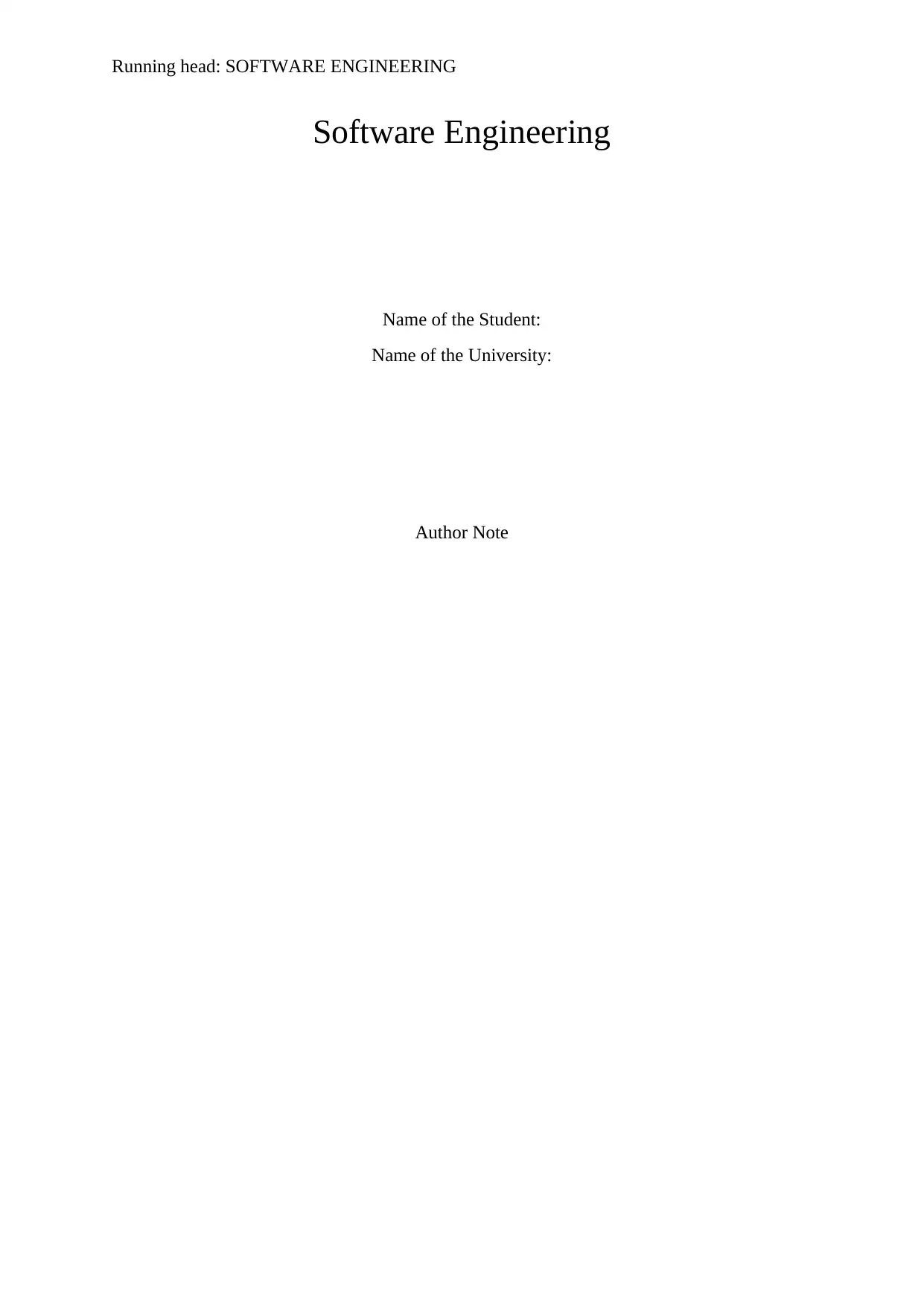
Running head: SOFTWARE ENGINEERING
Software Engineering
Name of the Student:
Name of the University:
Author Note
Software Engineering
Name of the Student:
Name of the University:
Author Note
Paraphrase This Document
Need a fresh take? Get an instant paraphrase of this document with our AI Paraphraser
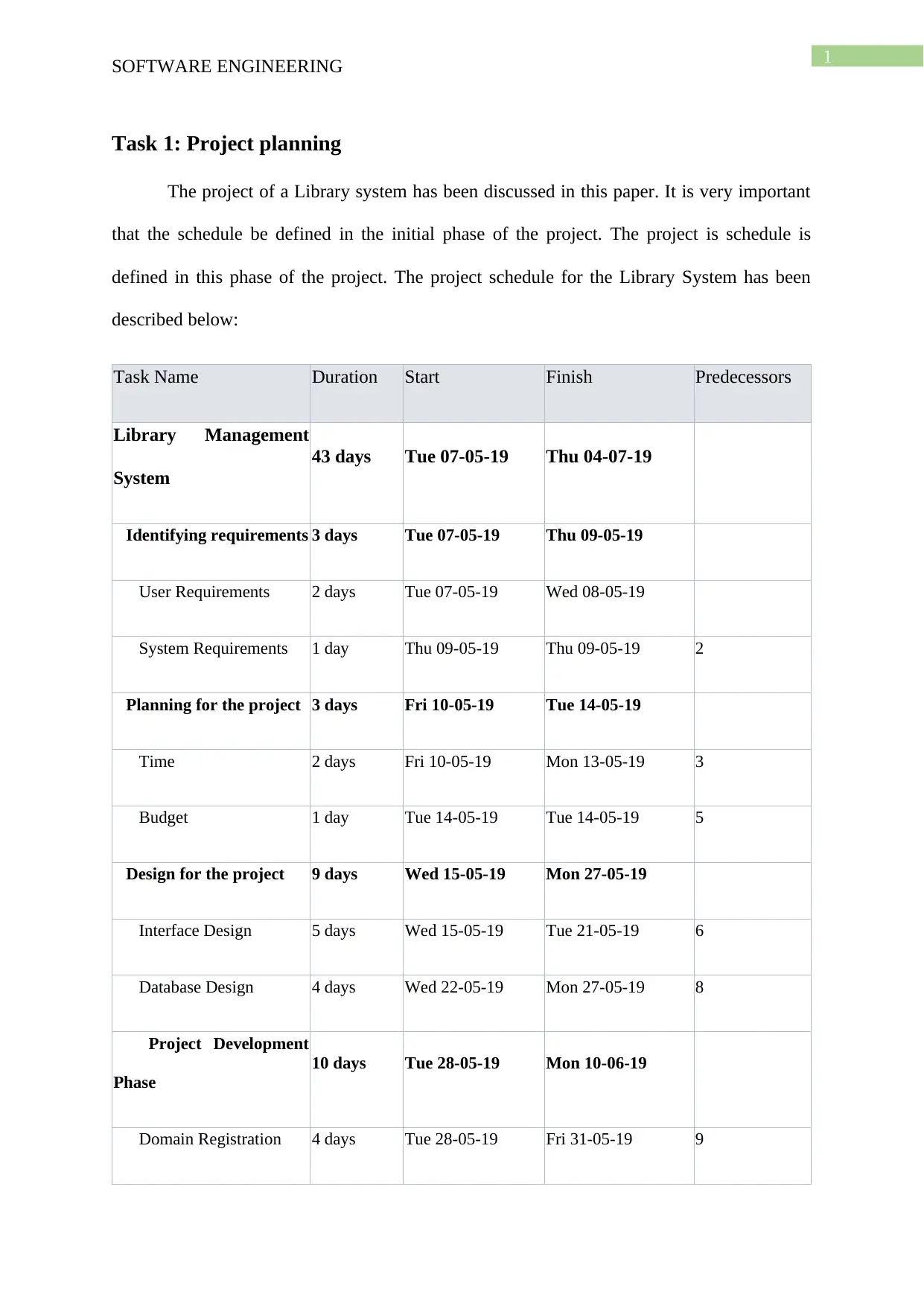
1
SOFTWARE ENGINEERING
Task 1: Project planning
The project of a Library system has been discussed in this paper. It is very important
that the schedule be defined in the initial phase of the project. The project is schedule is
defined in this phase of the project. The project schedule for the Library System has been
described below:
Task Name Duration Start Finish Predecessors
Library Management
System
43 days Tue 07-05-19 Thu 04-07-19
Identifying requirements 3 days Tue 07-05-19 Thu 09-05-19
User Requirements 2 days Tue 07-05-19 Wed 08-05-19
System Requirements 1 day Thu 09-05-19 Thu 09-05-19 2
Planning for the project 3 days Fri 10-05-19 Tue 14-05-19
Time 2 days Fri 10-05-19 Mon 13-05-19 3
Budget 1 day Tue 14-05-19 Tue 14-05-19 5
Design for the project 9 days Wed 15-05-19 Mon 27-05-19
Interface Design 5 days Wed 15-05-19 Tue 21-05-19 6
Database Design 4 days Wed 22-05-19 Mon 27-05-19 8
Project Development
Phase
10 days Tue 28-05-19 Mon 10-06-19
Domain Registration 4 days Tue 28-05-19 Fri 31-05-19 9
SOFTWARE ENGINEERING
Task 1: Project planning
The project of a Library system has been discussed in this paper. It is very important
that the schedule be defined in the initial phase of the project. The project is schedule is
defined in this phase of the project. The project schedule for the Library System has been
described below:
Task Name Duration Start Finish Predecessors
Library Management
System
43 days Tue 07-05-19 Thu 04-07-19
Identifying requirements 3 days Tue 07-05-19 Thu 09-05-19
User Requirements 2 days Tue 07-05-19 Wed 08-05-19
System Requirements 1 day Thu 09-05-19 Thu 09-05-19 2
Planning for the project 3 days Fri 10-05-19 Tue 14-05-19
Time 2 days Fri 10-05-19 Mon 13-05-19 3
Budget 1 day Tue 14-05-19 Tue 14-05-19 5
Design for the project 9 days Wed 15-05-19 Mon 27-05-19
Interface Design 5 days Wed 15-05-19 Tue 21-05-19 6
Database Design 4 days Wed 22-05-19 Mon 27-05-19 8
Project Development
Phase
10 days Tue 28-05-19 Mon 10-06-19
Domain Registration 4 days Tue 28-05-19 Fri 31-05-19 9
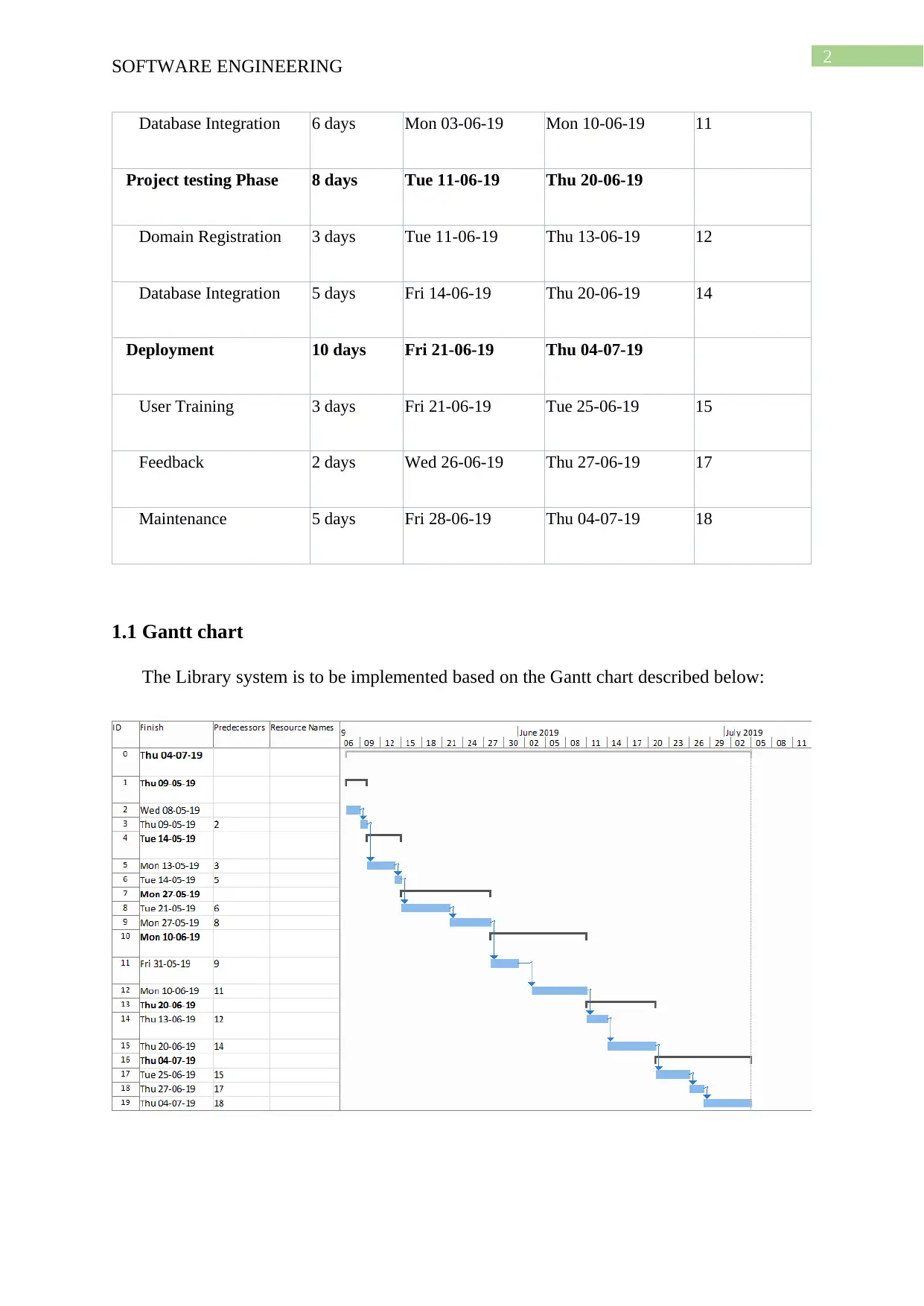
2
SOFTWARE ENGINEERING
Database Integration 6 days Mon 03-06-19 Mon 10-06-19 11
Project testing Phase 8 days Tue 11-06-19 Thu 20-06-19
Domain Registration 3 days Tue 11-06-19 Thu 13-06-19 12
Database Integration 5 days Fri 14-06-19 Thu 20-06-19 14
Deployment 10 days Fri 21-06-19 Thu 04-07-19
User Training 3 days Fri 21-06-19 Tue 25-06-19 15
Feedback 2 days Wed 26-06-19 Thu 27-06-19 17
Maintenance 5 days Fri 28-06-19 Thu 04-07-19 18
1.1 Gantt chart
The Library system is to be implemented based on the Gantt chart described below:
SOFTWARE ENGINEERING
Database Integration 6 days Mon 03-06-19 Mon 10-06-19 11
Project testing Phase 8 days Tue 11-06-19 Thu 20-06-19
Domain Registration 3 days Tue 11-06-19 Thu 13-06-19 12
Database Integration 5 days Fri 14-06-19 Thu 20-06-19 14
Deployment 10 days Fri 21-06-19 Thu 04-07-19
User Training 3 days Fri 21-06-19 Tue 25-06-19 15
Feedback 2 days Wed 26-06-19 Thu 27-06-19 17
Maintenance 5 days Fri 28-06-19 Thu 04-07-19 18
1.1 Gantt chart
The Library system is to be implemented based on the Gantt chart described below:
⊘ This is a preview!⊘
Do you want full access?
Subscribe today to unlock all pages.

Trusted by 1+ million students worldwide

3
SOFTWARE ENGINEERING
1.2 Trello Board
The Trello board link is provided below:
https://trello.com/b/tWpNXaSu/library-system
Task 2: Requirements Documentation
The “Pay Fine” scenario is having the following requirements and this includes the
following:
User requirements:
The most important user requirements that the library system is having is the function of
the librarian and the role of the member. Members would also be having the capability of
registering, borrowing and returning the books. The members would be capable of accessing
the books which are stored in the library only after registering themselves in the particular
branch. Followed by this the system would be associated with allowing the registered persons
in borrowing books. Whenever a member decides to borrow a book then the member must
assure that the book is returned within the time allocated. Besides this there is a need of
updating the system on a regular basis so as to have a clear view of the library system. After
the member returns the book the book would become available in the library system once
SOFTWARE ENGINEERING
1.2 Trello Board
The Trello board link is provided below:
https://trello.com/b/tWpNXaSu/library-system
Task 2: Requirements Documentation
The “Pay Fine” scenario is having the following requirements and this includes the
following:
User requirements:
The most important user requirements that the library system is having is the function of
the librarian and the role of the member. Members would also be having the capability of
registering, borrowing and returning the books. The members would be capable of accessing
the books which are stored in the library only after registering themselves in the particular
branch. Followed by this the system would be associated with allowing the registered persons
in borrowing books. Whenever a member decides to borrow a book then the member must
assure that the book is returned within the time allocated. Besides this there is a need of
updating the system on a regular basis so as to have a clear view of the library system. After
the member returns the book the book would become available in the library system once
Paraphrase This Document
Need a fresh take? Get an instant paraphrase of this document with our AI Paraphraser

4
SOFTWARE ENGINEERING
again and the other members would become capable of accessing and borrowing the book
once again.
Additionally, each member must have a library card so as to get a proper access of the
library and this card would be helping the librarian in providing access only to the registered
members. There also exists the need of storing the details of each and every book in the
system in a proper way. All the member ID are to be stored in the system whenever the
members borrow a book along with the details of the book which would mainly be done so as
to keep a proper record in the system.
Functional requirements:
The system must have the capability of storing entire data that are linked to the library as
well as the processes of the library. Below are the listed functional requirements of the library
system which would be implemented and this are:
Access database: The library system must be having the capability of maintaining the
data storage system which is associated allowing the members as well as the admin in
having access to the various type of data stored in the system. The database should
also be associated with the storage of details of the staffs of the system by making use
of the staff id or by means of the barcode. All the details of the students by usage of
the student ID is also to be done along with keeping a record of the books.
Borrowing of the books: The systems must be associated with providing the members
with the facility of borrowing one or more books from the library. The students would
be capable of visiting the system log so as to look for the materials that are required
by them and once, they find the material which are important to them they would
move on to the process of borrowing the book.
SOFTWARE ENGINEERING
again and the other members would become capable of accessing and borrowing the book
once again.
Additionally, each member must have a library card so as to get a proper access of the
library and this card would be helping the librarian in providing access only to the registered
members. There also exists the need of storing the details of each and every book in the
system in a proper way. All the member ID are to be stored in the system whenever the
members borrow a book along with the details of the book which would mainly be done so as
to keep a proper record in the system.
Functional requirements:
The system must have the capability of storing entire data that are linked to the library as
well as the processes of the library. Below are the listed functional requirements of the library
system which would be implemented and this are:
Access database: The library system must be having the capability of maintaining the
data storage system which is associated allowing the members as well as the admin in
having access to the various type of data stored in the system. The database should
also be associated with the storage of details of the staffs of the system by making use
of the staff id or by means of the barcode. All the details of the students by usage of
the student ID is also to be done along with keeping a record of the books.
Borrowing of the books: The systems must be associated with providing the members
with the facility of borrowing one or more books from the library. The students would
be capable of visiting the system log so as to look for the materials that are required
by them and once, they find the material which are important to them they would
move on to the process of borrowing the book.
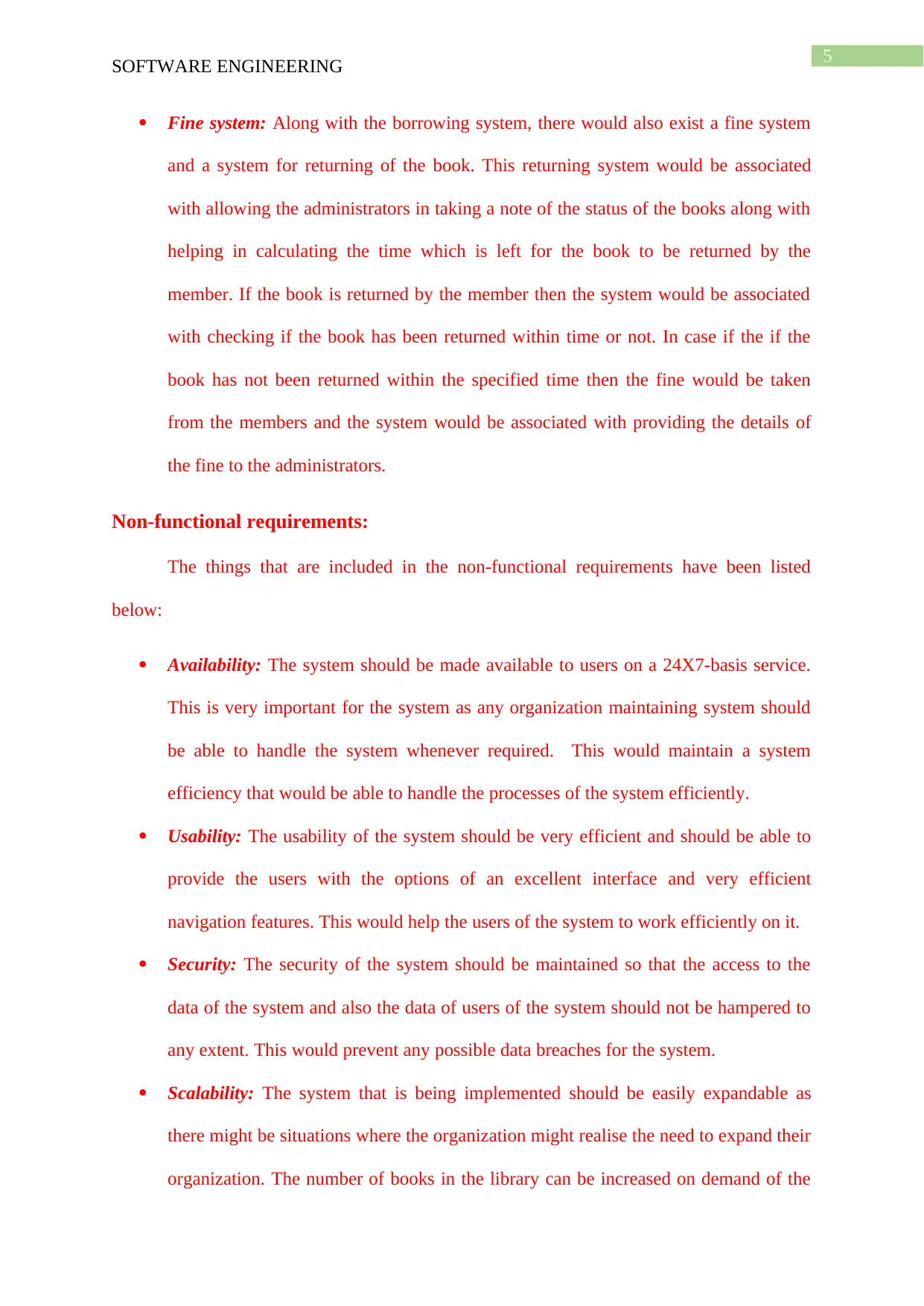
5
SOFTWARE ENGINEERING
Fine system: Along with the borrowing system, there would also exist a fine system
and a system for returning of the book. This returning system would be associated
with allowing the administrators in taking a note of the status of the books along with
helping in calculating the time which is left for the book to be returned by the
member. If the book is returned by the member then the system would be associated
with checking if the book has been returned within time or not. In case if the if the
book has not been returned within the specified time then the fine would be taken
from the members and the system would be associated with providing the details of
the fine to the administrators.
Non-functional requirements:
The things that are included in the non-functional requirements have been listed
below:
Availability: The system should be made available to users on a 24X7-basis service.
This is very important for the system as any organization maintaining system should
be able to handle the system whenever required. This would maintain a system
efficiency that would be able to handle the processes of the system efficiently.
Usability: The usability of the system should be very efficient and should be able to
provide the users with the options of an excellent interface and very efficient
navigation features. This would help the users of the system to work efficiently on it.
Security: The security of the system should be maintained so that the access to the
data of the system and also the data of users of the system should not be hampered to
any extent. This would prevent any possible data breaches for the system.
Scalability: The system that is being implemented should be easily expandable as
there might be situations where the organization might realise the need to expand their
organization. The number of books in the library can be increased on demand of the
SOFTWARE ENGINEERING
Fine system: Along with the borrowing system, there would also exist a fine system
and a system for returning of the book. This returning system would be associated
with allowing the administrators in taking a note of the status of the books along with
helping in calculating the time which is left for the book to be returned by the
member. If the book is returned by the member then the system would be associated
with checking if the book has been returned within time or not. In case if the if the
book has not been returned within the specified time then the fine would be taken
from the members and the system would be associated with providing the details of
the fine to the administrators.
Non-functional requirements:
The things that are included in the non-functional requirements have been listed
below:
Availability: The system should be made available to users on a 24X7-basis service.
This is very important for the system as any organization maintaining system should
be able to handle the system whenever required. This would maintain a system
efficiency that would be able to handle the processes of the system efficiently.
Usability: The usability of the system should be very efficient and should be able to
provide the users with the options of an excellent interface and very efficient
navigation features. This would help the users of the system to work efficiently on it.
Security: The security of the system should be maintained so that the access to the
data of the system and also the data of users of the system should not be hampered to
any extent. This would prevent any possible data breaches for the system.
Scalability: The system that is being implemented should be easily expandable as
there might be situations where the organization might realise the need to expand their
organization. The number of books in the library can be increased on demand of the
⊘ This is a preview!⊘
Do you want full access?
Subscribe today to unlock all pages.

Trusted by 1+ million students worldwide
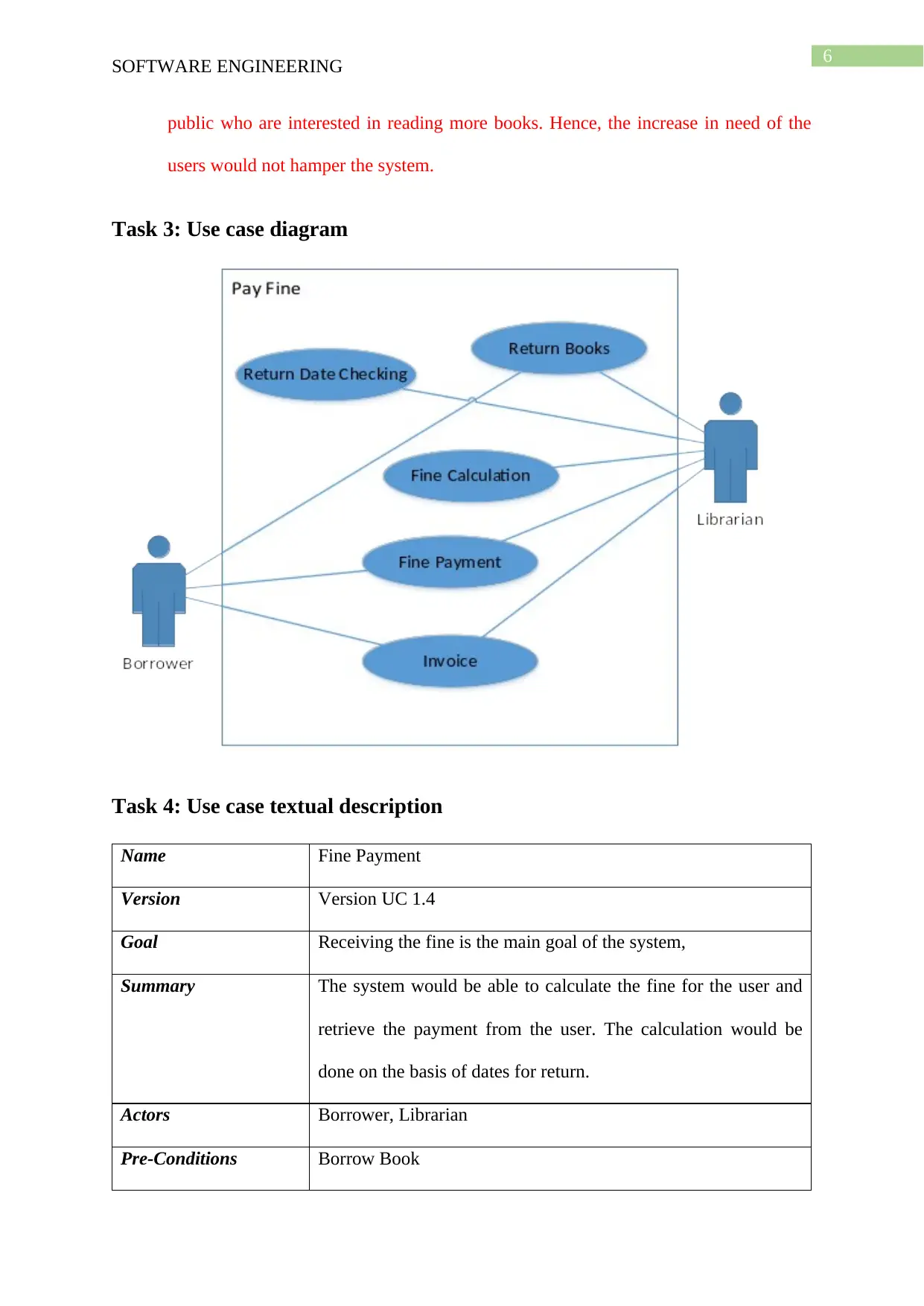
6
SOFTWARE ENGINEERING
public who are interested in reading more books. Hence, the increase in need of the
users would not hamper the system.
Task 3: Use case diagram
Task 4: Use case textual description
Name Fine Payment
Version Version UC 1.4
Goal Receiving the fine is the main goal of the system,
Summary The system would be able to calculate the fine for the user and
retrieve the payment from the user. The calculation would be
done on the basis of dates for return.
Actors Borrower, Librarian
Pre-Conditions Borrow Book
SOFTWARE ENGINEERING
public who are interested in reading more books. Hence, the increase in need of the
users would not hamper the system.
Task 3: Use case diagram
Task 4: Use case textual description
Name Fine Payment
Version Version UC 1.4
Goal Receiving the fine is the main goal of the system,
Summary The system would be able to calculate the fine for the user and
retrieve the payment from the user. The calculation would be
done on the basis of dates for return.
Actors Borrower, Librarian
Pre-Conditions Borrow Book
Paraphrase This Document
Need a fresh take? Get an instant paraphrase of this document with our AI Paraphraser
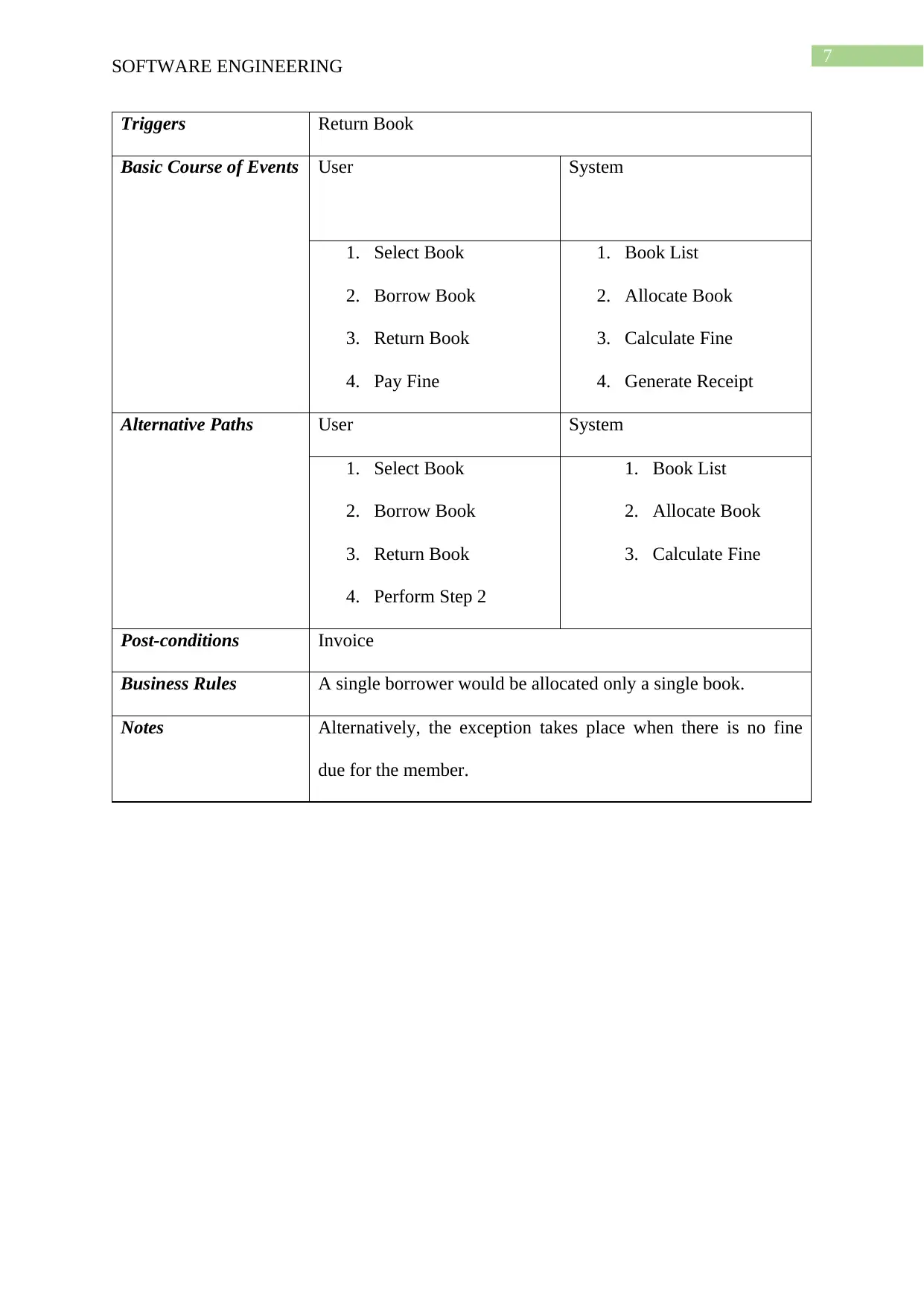
7
SOFTWARE ENGINEERING
Triggers Return Book
Basic Course of Events User System
1. Select Book
2. Borrow Book
3. Return Book
4. Pay Fine
1. Book List
2. Allocate Book
3. Calculate Fine
4. Generate Receipt
Alternative Paths User System
1. Select Book
2. Borrow Book
3. Return Book
4. Perform Step 2
1. Book List
2. Allocate Book
3. Calculate Fine
Post-conditions Invoice
Business Rules A single borrower would be allocated only a single book.
Notes Alternatively, the exception takes place when there is no fine
due for the member.
SOFTWARE ENGINEERING
Triggers Return Book
Basic Course of Events User System
1. Select Book
2. Borrow Book
3. Return Book
4. Pay Fine
1. Book List
2. Allocate Book
3. Calculate Fine
4. Generate Receipt
Alternative Paths User System
1. Select Book
2. Borrow Book
3. Return Book
4. Perform Step 2
1. Book List
2. Allocate Book
3. Calculate Fine
Post-conditions Invoice
Business Rules A single borrower would be allocated only a single book.
Notes Alternatively, the exception takes place when there is no fine
due for the member.
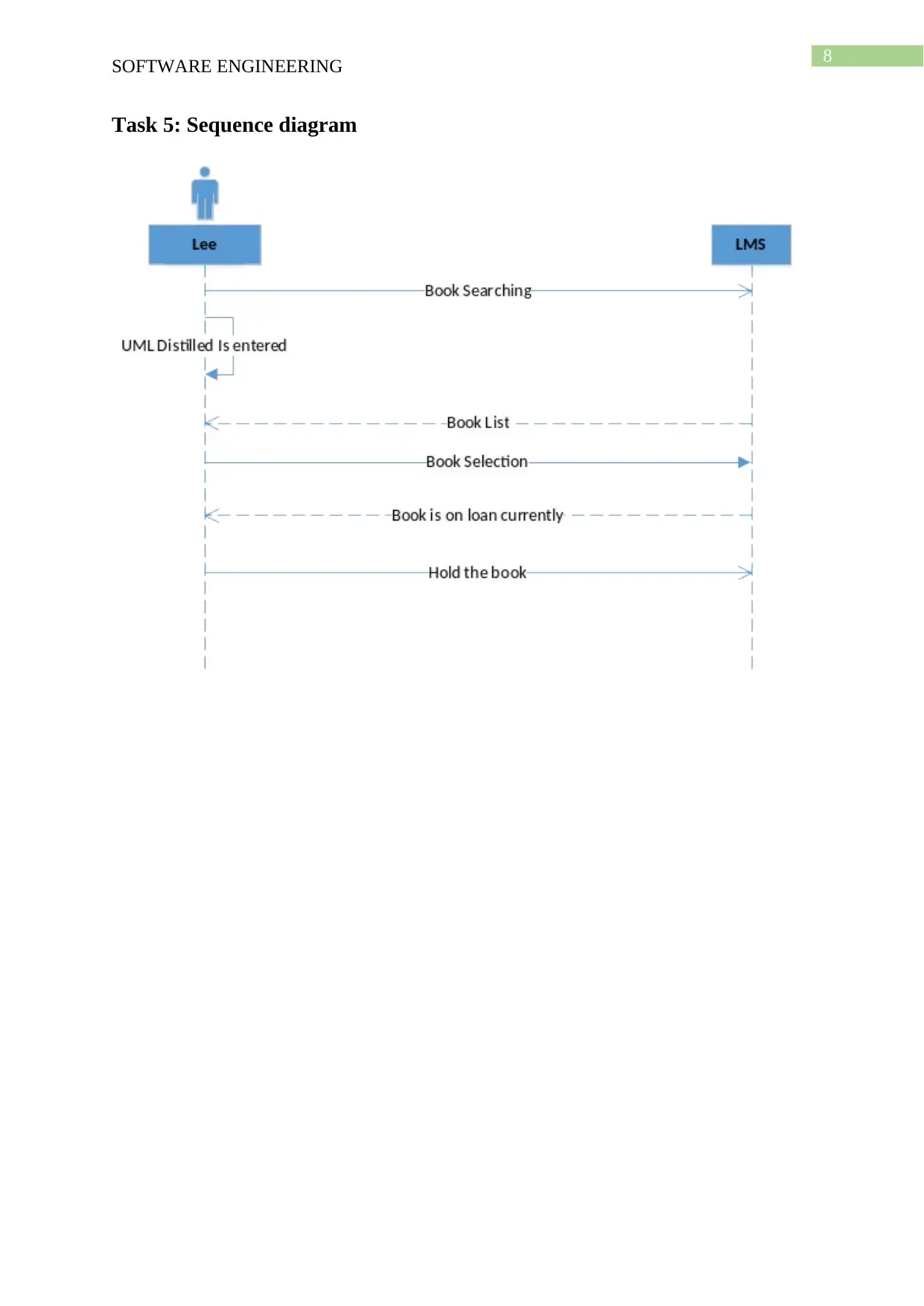
8
SOFTWARE ENGINEERING
Task 5: Sequence diagram
SOFTWARE ENGINEERING
Task 5: Sequence diagram
⊘ This is a preview!⊘
Do you want full access?
Subscribe today to unlock all pages.

Trusted by 1+ million students worldwide
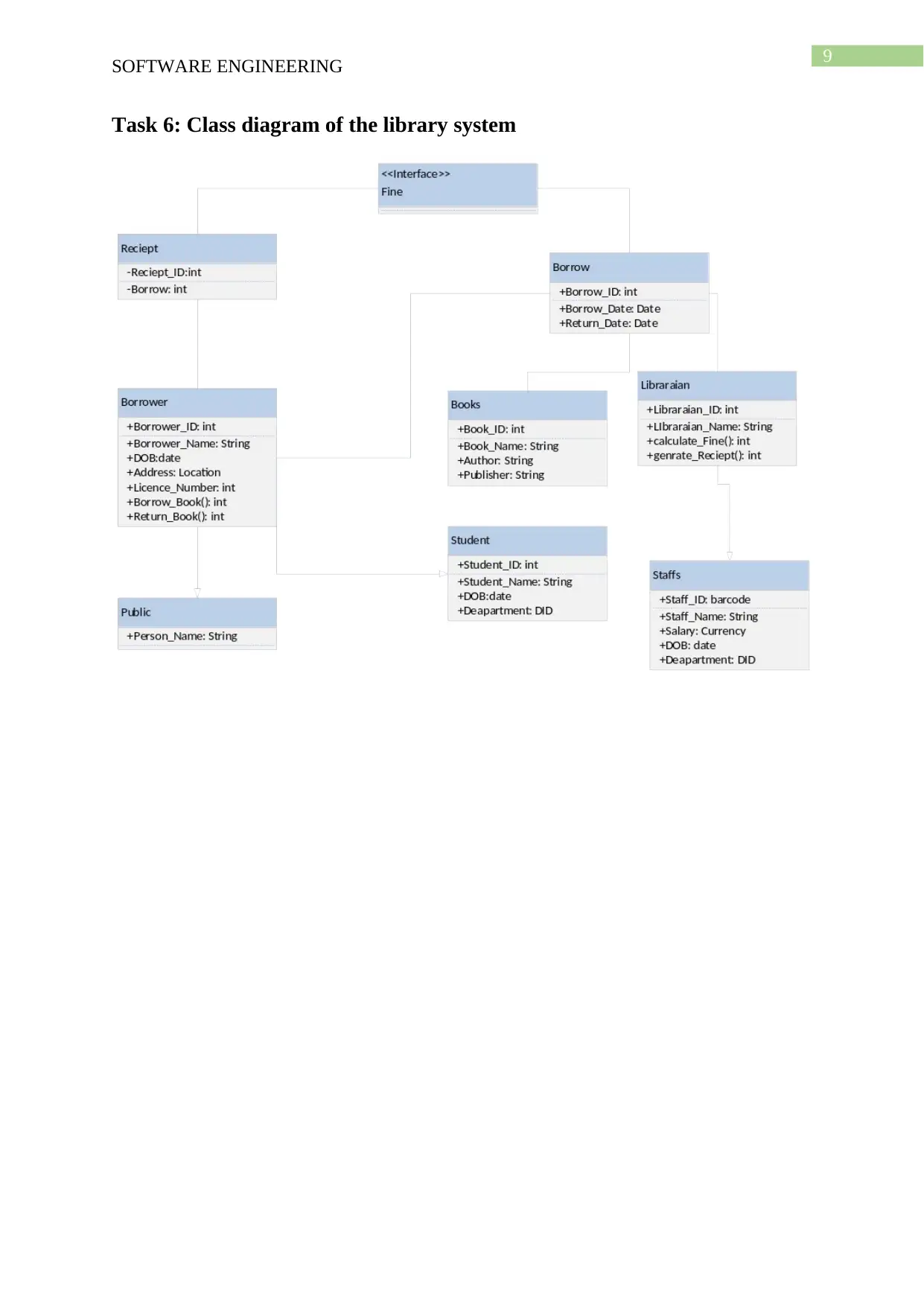
9
SOFTWARE ENGINEERING
Task 6: Class diagram of the library system
SOFTWARE ENGINEERING
Task 6: Class diagram of the library system
Paraphrase This Document
Need a fresh take? Get an instant paraphrase of this document with our AI Paraphraser
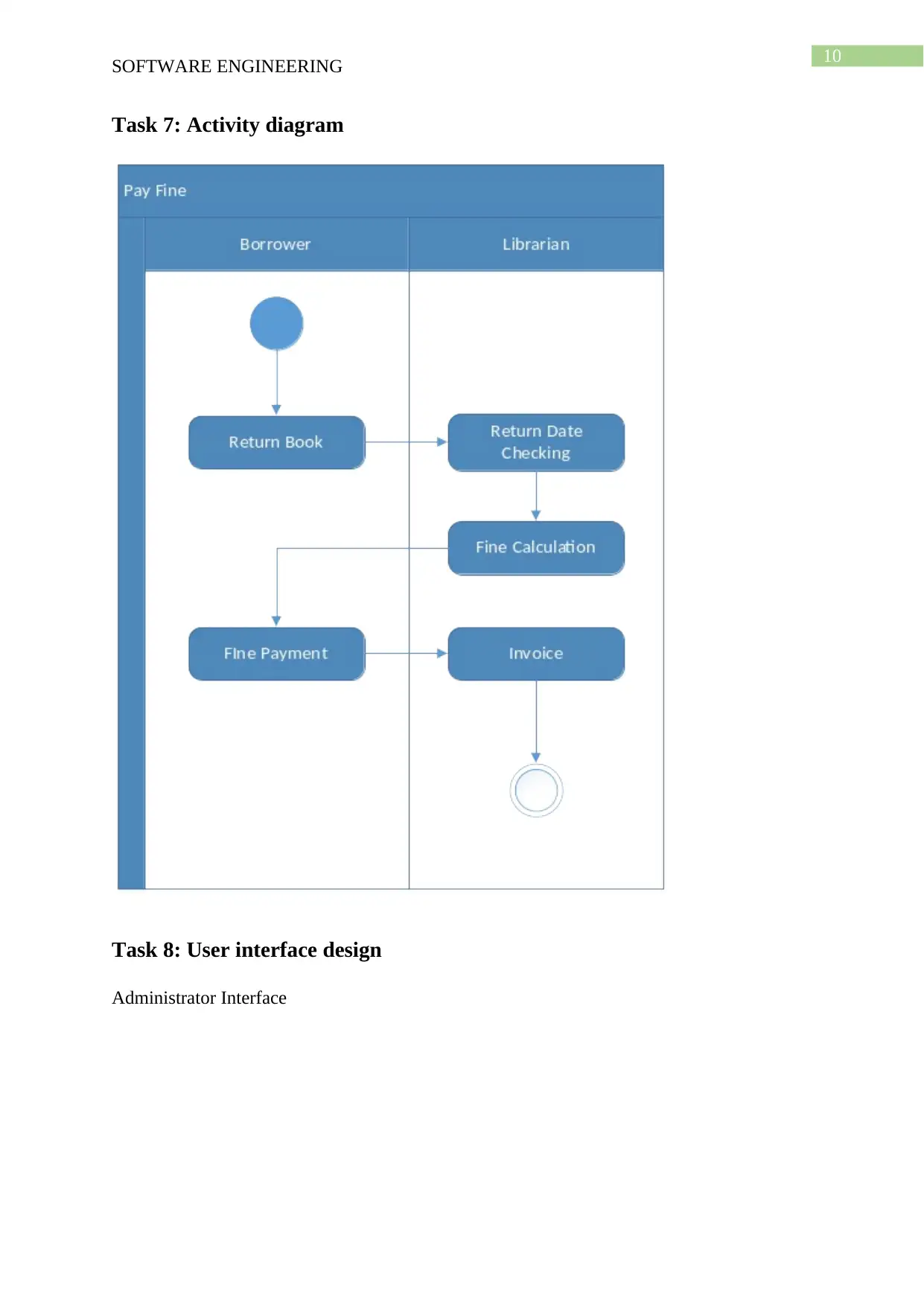
10
SOFTWARE ENGINEERING
Task 7: Activity diagram
Task 8: User interface design
Administrator Interface
SOFTWARE ENGINEERING
Task 7: Activity diagram
Task 8: User interface design
Administrator Interface
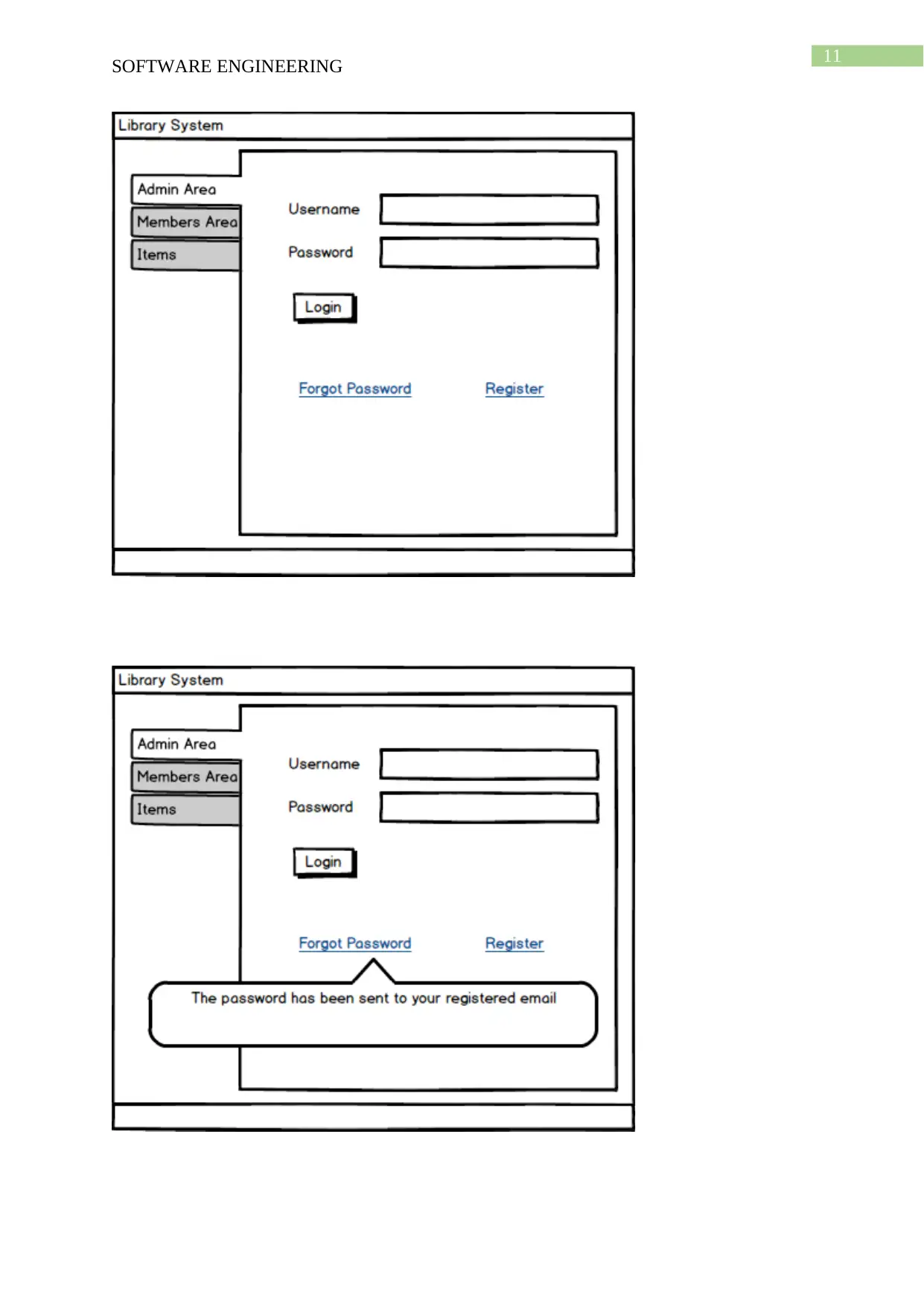
11
SOFTWARE ENGINEERING
SOFTWARE ENGINEERING
⊘ This is a preview!⊘
Do you want full access?
Subscribe today to unlock all pages.

Trusted by 1+ million students worldwide
1 out of 20
Related Documents
Your All-in-One AI-Powered Toolkit for Academic Success.
+13062052269
info@desklib.com
Available 24*7 on WhatsApp / Email
![[object Object]](/_next/static/media/star-bottom.7253800d.svg)
Unlock your academic potential
Copyright © 2020–2025 A2Z Services. All Rights Reserved. Developed and managed by ZUCOL.





